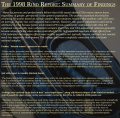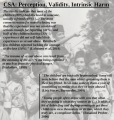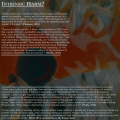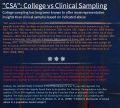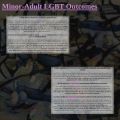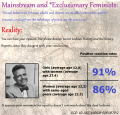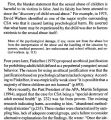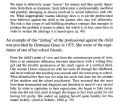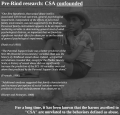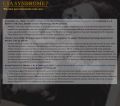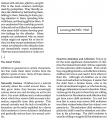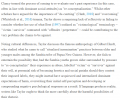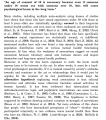One of our staff members is contributing considerably to a News Archiving service at Mu. Any well educated (Masters, PhD or above) users who wish to make comments on news sites, please contact Jim Burton directly rather than using this list, and we can work on maximising view count.
Research: Age of Innocence: Difference between revisions
The Admins (talk | contribs) Concept in development |
The Admins (talk | contribs) No edit summary |
||
| Line 1: | Line 1: | ||
{{research}} | {{research}} | ||
It is widely assumed that when ''forced or unwanted'' (a minority of) sexual contact does take place, younger minors are especially vulnerable to harm. This is said to manifest itself in the form of multiple psychological impairments in later life. Much like the idea that [[Research: Methodological flaws and syndrome construction|CSA "syndrome"]] takes on a certain observable form, these ideas are not supported by quantitative evidence. It instead appears that the perception of having been subjected to "abuse" is associated with negative psychological outcomes, regardless of the age at which the perceived abuse took place. | It is widely assumed that when ''forced or unwanted'' (a minority of) sexual contact does take place, '''younger''' minors are especially vulnerable to harm. This is said to manifest itself in the form of multiple psychological impairments in later life. Much like the idea that [[Research: Methodological flaws and syndrome construction|CSA "syndrome"]] takes on a certain observable form, these ideas are not supported by quantitative evidence. It instead appears that the perception of having been subjected to "abuse" is associated with negative psychological outcomes, regardless of the age at which the perceived abuse took place. | ||
Studies which focus on ''unrepresentative'' clinical samples rather than the wider population, have sometimes shown an association between age and severity of symptoms. This might be because of self-perception (abusive contacts before puberty are far rarer) and/or due to the higher prevalence of forced incestuous contacts at a younger age of first onset (incest is usually associated with more negative outcomes). | Studies which focus on ''unrepresentative'' clinical samples rather than the wider population, have sometimes shown an association between age and severity of symptoms. This might be because of self-perception (abusive contacts before puberty are far rarer) and/or due to the higher prevalence of forced incestuous contacts at a younger age of first onset (incest is usually associated with more negative outcomes). | ||
Revision as of 15:34, 28 July 2022
 | ||||||||||||
| Part of NewgonWiki's research project | ||||||||||||
|---|---|---|---|---|---|---|---|---|---|---|---|---|
|
| ||||||||||||
| ||||||||||||
|
| ||||||||||||
| Template: Research - This template |
It is widely assumed that when forced or unwanted (a minority of) sexual contact does take place, younger minors are especially vulnerable to harm. This is said to manifest itself in the form of multiple psychological impairments in later life. Much like the idea that CSA "syndrome" takes on a certain observable form, these ideas are not supported by quantitative evidence. It instead appears that the perception of having been subjected to "abuse" is associated with negative psychological outcomes, regardless of the age at which the perceived abuse took place.
Studies which focus on unrepresentative clinical samples rather than the wider population, have sometimes shown an association between age and severity of symptoms. This might be because of self-perception (abusive contacts before puberty are far rarer) and/or due to the higher prevalence of forced incestuous contacts at a younger age of first onset (incest is usually associated with more negative outcomes).
It should also be noted that these studies (which insist on self-perceived abuse and/or use of force) are fundamentally different to the Rind/Daly type studies which canvass for all legally defined "CSA" regardless of force or perception of abuse, or meta-analyze such data. With the latter type of study, it may well be the case that younger "victims" of legally-defined CSA go on to perceive these events as more negative, however, concrete psychological outcomes have not been observed to follow any significant trend. The reasons for this more negative self-perception may again be related to wider social factors such as the taboo on sex with prepubescent children, higher frequency of incest and a higher frequency of opportunistic, low-quality interactions owing to the underprivileged social position of smaller children. As a result of this, and the tendency of older minors to be more open to initiating a contact, coercive contacts are likely to be overrepresented in the younger age group.
Excerpt Graphic Library
The EGL on Harm covers some adjacent topics, and we will produce a graphic reviewing this topic soon. Just right click/save and reproduce by uploading in short-form media to bypass character limits.
-
Basic Rind Paradox infographic
-
Summarized Rind findings
-
Rind and Tromovitch (2000) on Iatrogenic Harm
-
Research pointing to no intrinsic harm profiled in The Guardian
-
What victimologists say about youth perception + admissions of iatrogenic harm
-
Self-perception: Importance
-
Some reading on secondary harm and perception/situational variables
-
More secondary harms
-
Intrinsic vs secondary harm
-
Daly's 2021 repetition of Rind (1998), finds that self-perception is far more important that abuse status
-
Lahtinen Report: Most common reason for not reporting - event not serious enough
-
Bender. Sexologist's observations in 1969
-
College outcomes: Benefits of college samples
-
LGBT outcome/perception data (links to papers in this release)
-
Arreola 2009 - Psych outcomes for LGBT "CSA" identical to no sex
-
Simpler way of expressing Lesbian outcomes (ref to modern feminism)
-
Further distillation of Rind's Kinsey analysis
-
Finer analysis of Finnish Victimization Survey (Rind)
-
General reading on intrinsic harm
-
Oellerich on the self-fulfilling prophecy of iatrogenic harm
-
Oellerich comments further on iatrogenic harm
-
CSA harm was known to be confounded even before Rind
-
No "typical" CSA reaction or "syndrome"
-
Rind on methodological issues/limitations of victimology
-
The Lanning (1992) report - full of hysterical conjecture, nevertheless describes the "most common" forms of offender and victim in banal terms that are applicable to most relationships (in order to prepare investigators to pathologize banality)
-
Percy Foundation review of Chloe Taylor: "Foucault, Feminism, & Sex Crimes"
-
2022 debate response
-
Illinois state investigation finds a "pedophile" was his victims' "best friend"

